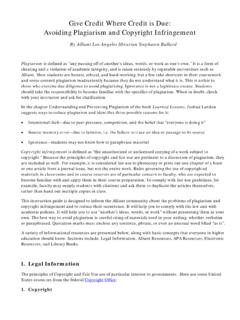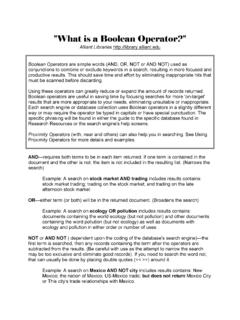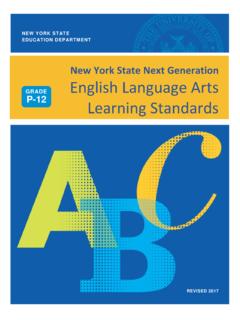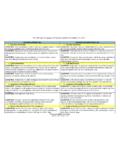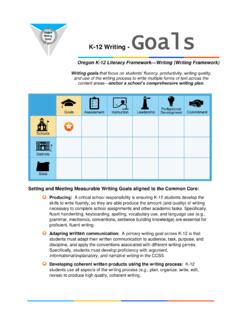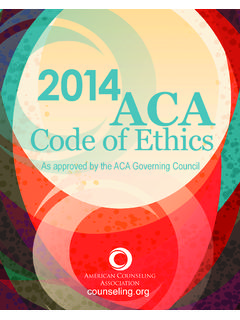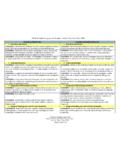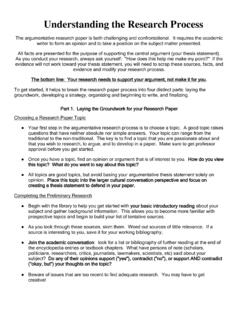Transcription of Avoiding Plagiarism and Copyright Infringement
1 Give Credit Where Credit is Due: Avoiding Plagiarism and Copyright Infringement By Alliant Los Angeles librarian Stephanie Ballard Plagiarism is defined as any passing off of another s ideas, words, or work as one s own. It is a form of cheating and a violation of academic integrity, and is taken seriously by reputable universities such as Alliant. Most students are honest, ethical, and hard-working, but a few take shortcuts in their coursework and some commit Plagiarism inadvertently because they do not understand what it is.
2 This is unfair to those who exercise due diligence to avoid plagiarizing. Ignorance is not a legitimate excuse. Students should take the responsibility to become familiar with the specifics of Plagiarism . When in doubt, check with your instructor and ask for clarification. In the chapter understanding and Preventing Plagiarism of the book Learned Lessons, Joshua Landau suggests ways to reduce Plagiarism and identifies three possible reasons for it: Intentional theft due to peer pressure, competition, and the belief that everyone is doing it Source-memory error due to laziness, the failure to trace an idea or passage to its source Ignorance students may not know how to paraphrase material Copyright Infringement is defined as the unauthorized or unlicensed copying of a work subject to Copyright .
3 Because the principles of Copyright and fair use are pertinent to a discussion of Plagiarism , they are included as well. For example, it is considered fair use to photocopy or print out one chapter of a book or one article from a journal issue, but not the entire work. Rules governing the use of copyrighted materials in classrooms and in course reserves are of particular concern to faculty, who are expected to become familiar with and apply them in their course preparation. To comply with fair use guidelines, for example, faculty may supply students with citations and ask them to duplicate the articles themselves, rather than hand out multiple copies in class.
4 This instruction guide is designed to inform the Alliant community about the problems of Plagiarism and Copyright Infringement and to reduce their occurrence. It will help you to comply with the law and with academic policies. It will help you to use another s ideas, words, or work without presenting them as your own. The best way to avoid Plagiarism is careful citing of materials used in your writing, whether verbatim or paraphrased. Quotation marks must enclose any sentence, phrase, or even an unusual word lifted as is . A variety of informational resources are presented below, along with basic concepts that everyone in higher education should know.
5 Sections include: Legal Information, Alliant Resources, APA Resources, Electronic Resources, and Library Books. I. Legal Information The principles of Copyright and Fair Use are of particular interest to governments. Here are some United States resources from the federal Copyright Office: 1. Copyright Avoiding Plagiarism and Copyright Infringement2 Copyright is based on the idea that we are all entitled to the fruits of our labors. It is the ownership of intellectual property, like the patent, the trademark, and the trade secret.
6 Copyright is a legal concept giving the creator of an original work of authorship exclusive rights to it, usually for a limited time, after which the work enters the public domain. Generally, it is "the right to copy", but also gives the Copyright holder the right to be credited for the work, to determine who may adapt the work to other forms, who may perform the work, who may financially benefit from it, etc. The Copyright Act of 1976 remains the primary basis of Copyright law in the United States, although it has been amended several times.
7 Title 17 of the Code spells out the rights of Copyright holders and provides for the protection of intellectual property. To qualify for Copyright protection, a work must be original, creative to a minimal degree, and in a fixed or tangible form of expression. It does not cover: works in the public domain; facts and ideas; works that lack originality; and freeware. The Act also outlines the Fair Use Doctrine, which permits the use of copyrighted material for educational purposes. 2. Fair Use An important part of Copyright law is the Fair Use Doctrine.
8 It was designed to balance the rights of a work s creator with the work s potential benefit to society, as well as free speech rights. Fair Use allows the photocopying, downloading and printing of copyrighted works, without securing permission, for these purposes: criticism, comment, news reporting, teaching, scholarship, and research. The following four factors must be considered when determining if the use or duplication of a work is legal: a. Purpose and character of the use OK for educational but not commercial purposes. You cannot make a monetary profit.
9 B. Nature of the copyrighted work A rather vague concept, it refers to a range of protection depending on whether the original work is factual (less protected) or creative/fictional (more protected). c. Amount of the portion used in relation to the whole work OK to duplicate a small amount, specifically: Single chapter from a book Single article from a journal Short story, essay, or poem from an individual work Avoiding Plagiarism and Copyright Infringement3 Chart, graph, diagram, drawing, cartoon, or picture per book, journal or newspaper (provided that the individual illustration is not copyrighted) d.
10 Effect of use on the potential market or value of the copyrighted work Duplication should not harm the commercial value of a work, that is, it is not a substitute for actually purchasing a book, music recording, etc. 3. Educators and researchers There are further restrictions on the duplication and distribution of copyrighted materials for the classroom and course reserves. Fair Use of these materials must meet the tests of brevity, spontaneity, and cumulative effect. Each copy distributed must include a notice of Copyright . It is the responsibility of faculty members to secure permissions.
